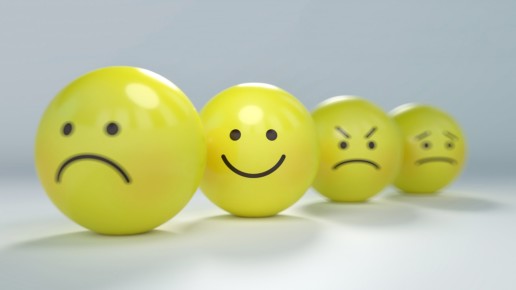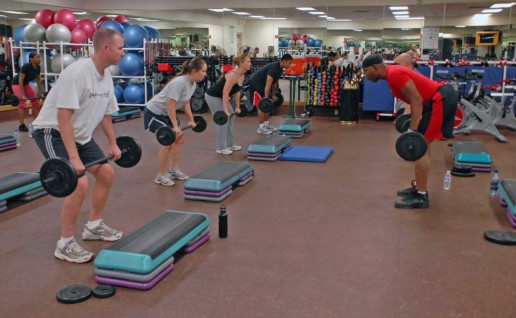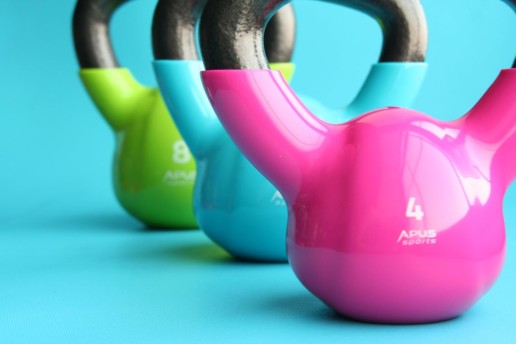How to make on-demand fitness work for wellness
Does your business offer on-demand, virtual fitness to their employees? This new technology is making it easier for people to engage in physical activity. Continue reading to learn more.
The way we work out is changing. Technology makes it possible to watch movies, order meals, even rent bikes on our own terms, and people increasingly expect their fitness options to be just as easy. Enter on-demand, virtual fitness.
The demand for virtual fitness is booming. In the United States alone, the virtual fitness market is expected to reach $2.6 billion by 2022. Whether people are too intimidated to go to the gym, have difficulty finding time in their schedules to attend a class, or have difficulty finding classes that fit their needs — virtual fitness makes it easy for them to engage over time.
As a result, more employers are realizing the value of investing in employee health and the benefits of keeping employees physically active. Lack of physical activity contributes to numerous health risks, which can lead to increased healthcare costs and lost productivity. Physical activity has also been found to have a positive impact on mental health and well-being. For example, it’s been estimated that employees who are in poor health are twice as likely as their healthier coworkers to be disengaged from work.
On-demand, virtual fitness is an option that can be more affordable than establishing an on-site gym, and with 35% of employees working remotely, on-demand fitness allows employers to offer the workouts to more employees.
As would-be fitness fanatics increasingly turn to apps to help tone their abs, what should employers know to ensure success? Here are a few strategies.
1. Make it personal. It’s a simple concept: People will be more likely to exercise if they find a workout that appeals to them. The best on-demand options offer classes for a wide range of interests — from cycling to yoga to kickboxing, to mom-and-baby fitness or simple stretching.
2. Make it flexible. People come in all shapes, sizes, and fitness levels. Make sure classes work even if your employees aren’t super fit. Even better, look for something that offers users a natural progression from wherever they start to higher levels of fitness.
3. Make it accessible. The whole point of virtual fitness is that people can take part anytime and anywhere. Look for programming that makes classes available online from a desktop or laptop computer and on both Android and iOS-based smartphones or tablets. This allows employers to make fitness available during lunchtime in the break room, while also giving employees access to short exercises they can do during a break at their desks or even on the road.
4. Make it trackable. Virtual fitness programming can be integrated into your benefits portal to allow for tracking of wellness incentive points. This encourages employees to track their progress and to create a virtual community that encourages the success of all its members.
Today’s workforce is tech-savvy, and that dynamic is only going to become more prevalent. Using mobile devices or apps to give employees what they need to balance life and work will continue to be a smart move for employers.
This article originally appeared in Employee Benefit News.
SOURCE: Von Bank, J. (30 November 2018) "How to make on-demand fitness work for wellness" (Web Blog Post). Retrieved from https://www.employeebenefitadviser.com/opinion/tips-to-make-on-demand-fitness-work-for-your-wellness-program?brief=00000152-146e-d1cc-a5fa-7cff8fee0000
Changing the conversation on mental health
Canadian employer, Bell, has helped fund the National Standard for Psychological Health and Safety in efforts to provide voluntary guidelines, tools and resources for employers to utilize. Continue reading to learn more.
NEW ORLEANS — With no existing standard for how to deal with mental health issues from a workplace perspective, one Canadian employer aimed to tackle the stigma around discussing mental illness, using steps that U.S. employers can follow.
Bell, the telecom giant headquartered in Montreal, has helped change the landscape for mental health in Canada by creating a set of guidelines employers can use as they put in place policies that encourage conversations around mental health.
“When we first went on our journey to establish workplace best practices, we couldn’t find any established guidelines,” Monika Mielnik, senior consultant, human resources, workplace health at Bell, said last week at the Benefits Forum & Expo, hosted by Employee Benefit News and Employee Benefit Adviser.
So the company helped fund the National Standard for Psychological Health and Safety to provide a voluntary set of guidelines, tools and resources employers can use.
There are 13 psychological factors within the guide, ranging from workload management and organizational culture to engagement, recognition and reward, which Mielnik says is “low-hanging fruit” for employers looking for a place to start.
Mielnik offers five steps for employers looking to build a successful program that promotes psychological health in the workplace: Commitment and awareness, support services, mental health training, return to work and accommodation processes, and the ability to measure progress.

Before starting out, Mielnik added, “it’s important to engage individuals across the organization to establish successful mental health initiatives.” Getting executive support and sponsorship, a dedicated mental health leader, and cross-functional involvement are also key.
And while commitment is important, awareness is equally necessary, she added. Bell has three annual campaigns with events aimed at engaging and educating employees across the country to address stigma and create a supportive and inclusive environment: Bell Let’s Talk (January), Mental Health Week (May) and Mental Illness Awareness Week (October).
“Understanding there is stigma and taboo around mental health, we want to make sure our employees are educated and aware of the impact it can have on them, their spouses, and others,” she said.
Bell partnered with digital wellness platform LifeSpeak in 2013 to provide employees with around-the-clock access to tools and assistance programs. In addition, Bell created a dedicated intranet page to provide weekly articles and an on-demand video library.
Bell employees access LifeSpeak 97% of the calendar days, said panelist Danny Weill, VP of partnerships at LifeSpeak. “This has become part of their culture. I like how Bell walks the walk. They do all this amazing stuff in the community, and then they do this stuff in the workplace, which is ultimately good,” he said.
In addition to access, mental health training is a huge part of the culture at Bell.
All employees are required to complete the building blocks to positive mental health training – which includes six interactive modules to help improve and maintain their own mental health.
Further, workplace mental health leadership is mandatory for all leaders within the organization. “This training equips leaders with a better understanding of mental health and [helps them to] be better equipped to have a conversation with employees,” she said. “That has been very key for us.” More than 10,000 leaders have been trained to date.
Part of leadership training includes return-to-work processes, as well as accommodation programs, she noted.
Measuring progress within the organization is an important final component of her five-step plan.
“When we took on this cause in 2010, we did it to make a lasting and significant impact,” she said. Dollars and percentages linked to such things as long- and short-term disability rates, utilization of benefits, etc., can all be measured for success, she added.
Bell noted a positive impact over a two- to three-year period, including a 20% reduction in mental health-related short-term disability and a 50% reduction in relapse and reoccurrence rates.
“One key area, and something we did early, is to take a pulse and baseline check with what’s occurring right,” she said. “Look at your short-term claims or any metric results you have that can speak to the mental health area in your workplace.”
There is a misconception that you have to start big and re-create the wheel when it comes to mental health programs, Mielnik said. “Look at metrics and programs in place and either build off or enhance those programs, but that baseline will be a good place to start.”
SOURCE: Otto, N. (3 October 2018) "Changing the conversation on mental health" (Web Blog Post). Retrieved from: https://www.benefitnews.com/news/changing-the-conversation-on-mental-health?feed=00000152-18a4-d58e-ad5a-99fc032b0000
Do you have a strong foundation of best practices for your wellness program?
Nine out of 10 U.S. corporations offer some type of wellness initiative, according to a study by the International Foundation of Employee Benefit Plans. Read on to learn how you can improve involvement in your company's wellness program.
Wellness programs at the office are becoming increasingly popular, but not all of them are as successful as they could be. Here are three simple things you can do to improve involvement in your association’s wellness program.
The International Foundation of Employee Benefit Plan’s new study—A Closer Look: Workplace Wellness Trends—takes a deeper dive into data from one of its previously published studies, with an aim to “determine practices that lead to potential wellness success.”
To do so, IFEBP analyzed responses from 431 U.S. corporations and government entities, and what the foundation uncovered is that nine out of 10 of the respondents offer some type of wellness initiative.
But the wellness initiatives they offer vary, ranging from fitness challenges and employee assistance programs, to healthy food and drink choices in the kitchen and opportunities for employees to do charity work.
Employers’ goals for even instituting wellness initiatives differ widely too. “There are a lot of different reasons why employers have wellness programs,” said Julie Stich, associate vice president of content at IFEBP. “You want your employees to be healthier, not only to keep healthcare costs down, but you want to increase their morale, increase their productivity and efficiency while they’re in the office, [and] you want to cut back on absenteeism …”
No matter the program or the goals associated with it, here are a few ingredients IFEBP has found are essential in creating a successful wellness program:
Leadership involvement.
“What we’ve seen repeated over and over in our analysis of our data was the involvement of leadership,” Stich said. And it’s important that the leaders of the organization support it publicly and communicate about it with their employees, encouraging staff, for example, to go get their flu shot during work hours or get up from their desks and take a walk. But leadership participation in the initiative is also important. “When you’ve got a fitness challenge going on, you actually [want to] see the CEO taking their walk around the building as well,” Stich said.
Communication.
Employers might first ask their employees what they’d like to see in a wellness program, whether a flu shot or a lunch-and-learn session on stress management and then use that feedback in crafting the organization’s wellness program. But, after an organization has launched an initiative, “it’s important to always be reminding employees about your wellness program and its activities,” Stich said.
Incentives.
Offering incentives is a great way to motivate employee involvement in an organization’s wellness initiative. One way to do this is to put the names of staff who are participating in the program into a raffle and then hold a gift card drawing.
Stick it’s important to keep in mind that the results of such a program won’t be revealed quickly. “You’re not going to see a positive or any kind of ROI in the first year,” she said. “If you roll out a new program or a new component of your program, it takes on average three to five years before you can really get a good sense of whether this is working or not and what impact it’s having.”
SOURCE: Smith, K. (20 March 2018) "Do you have a strong foundation of best practices for your wellness program?" (Web Blog Post). Retrieved from https://www.provanthealth.com/industry-trends/2018/3/26/are-you-succeeding-at-the-three-the-foundational-elements-of-a-successful-program
Original source: Associations Now | Emily Bratcher | How to Boost the Success of Your Workplace Wellness Program
Employers Assess Risk Tolerance with Wellness Program Incentives
Do you offer wellness programs to your employees? Employers are now uncertain to what extent they can use incentives as part of a wellness program. Continue reading to learn more.
Employers designing 2019 wellness programs must decide what approach to take on program incentives without Equal Employment Opportunity Commission (EEOC) guidance on the Americans with Disabilities Act (ADA) and the Genetic Information Nondiscrimination Act (GINA).
The commission has a Notice of Proposed Rulemaking tentatively slated for January 2019. Last year, the U.S. District Court for the District of Columbia decided the commission's 2016 ADA and GINA wellness regulations were arbitrary and vacated them, effective Jan. 1, 2019.
Employers again are "in the uncomfortable position of not knowing with certainty whether and to what extent they can use incentives as part of a wellness program that involves medical examinations, disability-related inquiries and/or genetic information," wrote Lynne Wakefield and Emily Zimmer, attorneys with K&L Gates in Charlotte, N.C., in a joint statement.
The Society for Human Resource Management (SHRM) "has long advocated for proposals that will ensure consistency between the wellness rules that the EEOC has jurisdiction over, the ADA and GINA, with those provided under the ACA [Affordable Care Act]," said Nancy Hammer, SHRM vice president, regulatory affairs and judicial counsel. "While EEOC's 2016 rulemaking effort adopted the ACA's 30 percent incentive, it added new requirements that would have discouraged employers from providing wellness options for employees. We are hopeful that the EEOC is able to revisit the rules to ensure both consistency with existing rules and flexibility to encourage employers to adopt innovative programs to improve employee health and reduce costs."
ADA and GINA Requirements
Employers have long sought guidance over whether and when wellness program incentives—rewards or penalties for participating in biometric screenings and health risk assessments connected with the programs—comply with the ADA and GINA.
The ADA prohibits employers from conducting medical examinations and collecting employee medical history as part of an employee health program unless the employee's participation is voluntary, noted Ann Caresani, an attorney with Tucker Ellis in Cleveland and Columbus, Ohio.
GINA prohibits employers from requesting, requiring or purchasing genetic information from employees or their family members, unless the information is provided voluntarily.
The EEOC in 2000 asserted that for a wellness program to be voluntary, employers could not condition the receipt of incentives on the employee's disclosure of ADA- or GINA-protected information.
However, in 2016, the commission issued regulations providing that the use of a penalty or incentive of up to 30 percent of the cost of self-only coverage would not render involuntary a wellness program that seeks the disclosure of ADA-protected information. The regulations also permitted employers to offer incentives of up to 30 percent of the cost of self-only coverage for disclosure of information, in accordance with a wellness program, about the manifestation of a spouse's diseases or disorder, Caresani said.
Wakefield and Zimmer noted that the EEOC's 2016 wellness regulations applied to wellness programs that provided incentives tied to:
- Biometric screenings for employees and spouses.
- Disability-related inquiries directed at employees, which might include some questions on health risk assessments.
- Family medical history questions, such as risk-assessment questions that ask about the manifestation of disease or disorder in an employee's family member and/or such questions about the disease or disorder of an employee's spouse.
- Any other factors that involve genetic information.
Court Actions
The AARP challenged the 2016 rule, arguing that the 30 percent incentives were inconsistent with the voluntary requirements of the ADA and GINA. Employees who cannot afford to pay a 30 percent increase in premiums would be forced to disclose their protected information when they otherwise would choose not to do so, Caresani explained.
While the 30 percent cap was consistent with the Health Insurance Portability and Accountability Act (HIPAA) as amended by the ACA, the AARP said this was inappropriate, as HIPAA and the ADA have different purposes, noted Erin Sweeney, an attorney with Miller & Chevalier in Washington, D.C..
In addition, the change from prohibiting any penalty to permitting one of 30 percent was not supported by any data, according to the AARP.
In the summer of 2017, the U.S. District Court for the District of Columbia held that the EEOC's rule was arbitrary. The court sent the regulations back to the EEOC for further revisions.
In December 2017, the court vacated the 2016 rule after the EEOC initially said that the new rule would not be ready until 2021.
Conservative to Aggressive Approaches
Wakefield and Zimmer observed that employers may take several different approaches as they design wellness programs for next year:
- No incentives (most conservative approach). These types of wellness programs can still include biometric screening and health risk assessments that employees and spouses are encouraged to complete, but no rewards or penalties would be provided in connection with their completion.
- Modest incentives (middle-ground approach). A modest incentive is likely significantly less than 30 percent of the cost of self-only coverage, given the court's finding that the EEOC did not provide adequate justification for an incentive level-up to 30 percent.
- Up to 30 percent incentives (more aggressive approach). Although the court did not rule that a 30 percent incentive level would definitely cause a wellness program to be considered involuntary, incentives at this level after 2018 likely will expose employers to lawsuits, they wrote.
Multiple-Point Program
One good way to demonstrate compliance, they noted, is a multiple-point program in which participants engage in different activities and earn an incentive by participating in enough activities apart from biometric screenings, risk assessments or providing their spouse's health information.
For example, an employer could let employees take health care literacy quizzes or offer a program that measures a worker's activity as opposed to fitness, Caresani noted. She said, "Programs that are participatory are probably less effective than outcome-based programs, but they are more popular with employees and are less likely to pose litigation risks."
SOURCE: Smith, A. (1 August 2018) "Employers Assess Risk Tolerance with Wellness Program Incentives" (Web Blog Post). Retrieved from https://www.shrm.org/resourcesandtools/legal-and-compliance/employment-law/pages/risk-tolerance-wellness-program-incentives.aspx
Helping employers start the conversation around suicide prevention
The Center for Disease Control and Prevention reported that in 2016 suicide was the tenth-leading cause of death in the U.S. Continue reading to learn how employers can start the conversation around suicide prevention.
Suicide was the tenth-leading cause of death in the United States in 2016, claiming the lives of nearly 45,000 people, according to the Centers for Disease Control and Prevention. Given recent media coverage of the high-profile suicides of Kate Spade and Anthony Bourdain, employers should be more aware of how these events have a heightened impact on people’s mental health and well-being in the workplace.
Research has shown that the likelihood of suicide in vulnerable individuals increases immediately after publicity of these types of events. This phenomenon is known as suicide contagion or the increase in suicidal behavior following media exposure. While suicide prevention is not an easy conversation to have with clients, it’s an important one. Now is the perfect time to start the conversation with your clients on how they can play a crucial role in creating awareness and supporting employees who may be experiencing suicidal thoughts.
Here’s how benefit advisers and employers can navigate the conversation:
Discuss warning signs
Sharing information about common warning signs of symptomatic behavior can give your clients a greater understanding of how they can help employees get the support they need. Often, typical warning signs can be seen in declining work performance, poor hygiene, sudden weight changes, mood swings and depression.

While discussing these common symptoms, help break down the misconception that behavioral health also can be a sign of suicidal behavior. Explain that more than half of people who die of suicide did not have a known mental health condition. Often, individuals considering suicide cite other issues, including fear that they are a burden to others, stress about finances or struggles to afford or secure a place to live. Discuss these instances with your client so they are aware of other factors that could be contributing to their employee’s situation.
Discussing these symptoms can help ensure your clients have a better understanding of how to play a role in supporting and assisting at-risk employees.
Remove the stigma of behavioral health issues
While it’s true that not all suicides are related to a behavioral health condition, the stigma surrounding these conditions still exists and can prevent many individuals from approaching their employer or seeking assistance. By talking with your clients about this stigma, you can help remove the labels and negative connotations surrounding mental health conditions in the workplace.
Share with your clients the ways in which they can develop proactive open lines of communication around behavioral health conditions. For example, explain how they can reach out to employees to build awareness of the services they offer to those struggling. By incorporating educational campaigns that promote awareness of resources, your clients can help ensure employees get the assistance they need. In doing so, your clients can foster a workplace culture of acceptance and support.
Promote available resources
As you create awareness among your clients about the role they can play in removing the stigma, it’s also important their at-risk employees are aware of the resources available to them. Regardless of what their employees may be struggling with, suicidal thoughts or another behavioral health condition, it’s important for your clients to promote resources available through their employee benefits plan. For example, you can highlight how EAPs typically provide numerous free counseling sessions.
Clients also can work with their disability carrier to address employees’ behavioral health issues. Most disability carriers can assist with integrating existing benefit offerings with other resources to help ensure clients are providing their employees with robust treatment options. Additionally, disability carriers can recommend creative solutions and accommodations to meet employees’ unique conditions and support them staying at work or returning to work sooner.
The heightened attention around suicide prevention presents you with the opportunity to discuss the importance of suicide awareness in the workplace. In doing so, your clients can better support those who may be at risk and play a crucial role in creating an inclusive and supportive environment for their workforce.
This article originally appeared in Employee Benefit Adviser.
SOURCE: Jolivet, D. (24 September 2018) "Helping employers start the conversation around suicide prevention" (Web Blog Post). Retrieved from: https://www.benefitnews.com/opinion/helping-clients-start-the-conversation-about-suicide?feed=00000152-18a4-d58e-ad5a-99fc032b0000
What's a simple addition to your day to decrease stress & improve well-being?
Gratitude is more a state of mind rather than a personality trait, varying over the course of time. A recent study shows that gratitude reduces stress and fosters well-being. Continue reading to learn more.
Previous research on the positive effects of gratitude has shown that gratitude appears to reduce stress and foster well-being (e.g. Wood et al., 2010). A recent prospective study in which people were instructed to list things they were grateful for on a daily basis supports this notion (Krejtz et al., 2016). However, little if any, research has looked at whether spontaneous (non-directed) changes in gratitude track with well-being and stress response. Rather than being a stable personality characteristic (a “trait”), gratitude may be more of a “state,” varying over the course of time—or perhaps a combination of both. Do daily fluctuations in gratitude correlate with well-being and indicators of happiness, stress, and depression? Furthermore, does gratitude serve as a buffer for stress and negativity, helping to offset toxic effects on more challenging days?
In order to look more closely at how natural day-to-day levels of gratitude may interact with various indicators of well-being and stress, researchers Nezlek, Krejtz, Rusanowska and Holas (2018) followed 131 participants for two weeks, using daily self-assessments to investigate correlations among gratitude and factors related to well-being and stress. Daily measures included gratitude, positive and negative emotional states, self-esteem, depressogenic adjustment (optimism about oneself and life), worry, and rating of important events of the day on how stressful and how positive they were. Participants reported on 10 possible categories for events: family, interpersonal, partner, work, finances, official, health, hobby, values, and other/everyday events.
As in previous studies looking at intentionally cultivated gratitude, researchers found that on every measure, gratitude was significantly correlated with well-being. On days when people felt more grateful, well-being was reported as being higher. Likewise, on higher stress days, participants reported lower well-being, and on lower stress days, participants reported greater well-being.
Using gratitude to buffer stress responses.
Importantly, they found that gratitude did in fact appear to act as a buffer for stress. On days with fewer positive events, gratitude and well-being were more strongly related, suggesting that gratitude may serve to bolster resilience, amplifying lower positive emotions on difficult days or perhaps even providing, essentially, internal positive events to compensate for a lack of external positive events. This is especially noteworthy because people often have difficulty tapping into gratitude when difficulties arise, focusing on negatives with bitterness or pessimism.
Gratitude therefore appears to provision us internally with a positive response when external events fail to do so. For people who are able to muster up gratitude when the going gets rough, not only as a generally characteristic but also as a just-in-time response to stress and negative events, gratitude can be a “bridge over troubled water” that helps to keep us from getting pulled down into a negative spiral of maladaptive coping. People who use gratitude in this way must be able to do so, rather than undermining resilient responses.
Gratitude, compassion and resilience.
In keeping with research showing that resilience is related to cognitive flexibility, active coping, optimism, and related beliefs, the current research suggests that a subset of people use gratitude automatically, generating a state of mind which buffers negative events and stressful responses to sustain greater overall well-being. Religious belief, which often emphasizes gratitude, is also associated with greater levels of resilience. In addition, recent research by Abbondandolo and Sigal (2018) also found a positive relationship between self-compassion and active coping, suggesting that there are common pathways governing gratitude, self-compassion, and resilience.
Additional research is required to further understand the causal relationships between gratitude, resilience, well-being, and related factors in order to spell out what innate factors help make us stronger, as well as what interventions can bolster overall well-being. Understanding whether those who naturally utilize gratitude to buffer stress and sustain well-being tend to do this consciously or not, how they had learned to do so during the course of development, and whether there are intrinsic factors that predispose one to feel grateful would help us learn how to teach the effective use of gratitude—especially for those who have difficulty seeing for what, if anything, there is to be grateful.
SOURCE: Smith, K. (26 March 2018) "What's a simple addition to your day to decrease stress & improve well-being?" (Web Blog Post). Retrieved from: https://www.provanthealth.com/industry-trends/2018/3/26/whats-a-simple-addition-to-your-day-to-decrease-stress-improve-well-being
Original source: Psychology Today | Grant Hilary Brenner M.D. | How Does Spontaneous Gratitude Increase Daily Well-Being?
DISCOVER THE WELLNESS TRENDS FOR 2019
Did you know: A clear space equals a clear mind. Minimalism is one of the new wellness trends for the New Year. Read this blog post for more 2019 wellness trends.
It’s that time of year again when we cast our minds forward and bring you our predictions for the wellness trends that are set to relax, improve and make us feel better about ourselves in 2019. And let’s be honest it feels as if there’s a new trend every week at the moment, so we’ve sifted through the trend trough to tell you ALL about the ones you absolutely need to know about!
Reconnecting With Nature
As a predecessor to the digital detox trend of last year (although heaven knows we still haven’t mastered that one yet!) 2019 is all about shifting our backsides off of the sofa and actually *gasp* leaving our homes to reconnect with nature. The focus is very much on disconnecting i.e. leaving your phones and even your fitness trackers (sorry you’ll have to manage without the steps for this one) in order to reconnect. You see exercising outside is all well and good, but it starts to become detrimental when we begin putting too much pressure on ourselves to hit the next PB or when we become obsessed with comparing ourselves against our friends on the Fitbit leaderboard.
Hey, I’m all for healthy competition and that heady endorphin rush when you smash out an all-time best, but to truly enjoy the benefits of what nature can do for our health we need to unplug and pay attention to what is out there – without the distractions!
From moonlit yoga on the beach to forest bathing in the sensual shadiness of the beautiful English woodland, learning to embrace your inner mother nature is all about fine-tuning the senses. It’s essentially another branch of mindfulness that allows us to break free from the stressful trappings of the modern world and find inner peace and gratitude for the world around us.
Soothing Sounds
You must have that one song that makes you feel amazing? That song that no matter how down in the dumps you are, when you hear those first notes you’re up dancing and feeling as if nothing can stop you. Music’s funny like that isn’t it? It evokes all kinds of emotions in us – from positive uplifting vibes, sorrow and sadness, motivation and drive, right through to silliness and freedom of expression – music has a power over us like no other.
And the sound, of any description, is no different. Think about when you visit a spa, often there will be sounds of the rainforest, birds chattering in trees or that peaceful drift you off to sleep music, floating over the space, creating a calm and serene ambiance and helping you to relax and switch off.
Sound therapy works through the healing power of sound vibration and frequencies. All of us have our own natural frequencies and when we are exposed to the external frequencies of singing bowls, gongs, tuning forks, drums etc. and allow them to wash over us and resonate with us, natural healing of both the body and mind can begin to occur. For example, Tibetan singing bowls can help people to experience a deep sense of relaxation, which can relieve pain, help lower blood pressure, reduce stress, improve circulation and blood flow, balance the Chakras, create focus and emotional clarity and leave people feeling at peace and happy with themselves.
Everyone has the ability to connect with the healing power of sound and most important of all it gives us that chance to focus on just one of our senses, which in a world where our senses are continually blasted with information overload, this is one of life’s most simple of luxuries. Sound classes are becoming increasingly popular for this very reason and many also incorporate the practices of yoga and meditation within them to further aid the wellness experience.
Color Therapy
Do you have a favorite color? There’s a good reason why you are drawn to one color over another and it’s all to do with energy and the way it makes you feel.
Color is energy that is transmitted on different wavelengths and frequencies to create different colored light. There are seven shades of visible light, the rainbow colors, then there is white which contains all of the 7 shades, black which absorbs light and therefore appears void of color, and then there are literally millions of invisible colors that our eyes cannot see. Color therapy, or Chromotherapy to give it its official name, is all about using color to enhance our health and wellness in certain ways. Each color has its own vibrational frequency that relates to different physical symptoms and emotions.
BLUE – This is a calming color that is used to ease symptoms of pain, anxiety, depression and can even aid sleep. Yes I know we’re told the blue light emitted from our screens is bad for us, but that’s a synthetic digital light, so I’m afraid scrolling through Instagram in bed won’t have the same effect! Research has also shown that blue light can help lessen inflammation, lower fevers, reduce high blood pressure and relieve migraines, due to it’s cooling almost anesthetic style energy.
RED – The fiery, powerful color that denotes passion and confidence. It’s bold and powerful and will give you balls when you need it most. And as such, it is thought that being exposed to red light will increase your pulse, raise your blood pressure and increase your breathing rate. Doesn’t necessarily sound too good, right? But red is the color to energize, to motivate and to put yourself out there and show people you mean business. Infrared therapy is also used to activate collagen cells, stimulate the skin to help reduce the appearance of fine lines and wrinkles and can speed up the healing process.
YELLOW – This bright cheerful color does as you would expect; it uplifts, invokes optimism and a real sense of self love in a person.
GREEN – The color of nature, green is associated with harmony and it provides a neutral, positive and calming effect.
ORANGE – This color can raise energy levels and help improve mood, I mean who can’t but raise a smile when you see something bright orange!?!
PURPLE – The mean and moody one, the color of royalty, richness and luxury. Purple is the color for tranquility and works well in a detox sense, stripping the body and mind of impurities and can help patients deal with that sense of mind over matter when dealing with chronic pain.
And then there’s Colorstrology – a bit like astrology, but this is the idea that each birth month has its own color, which is a reflection of your personality. To find out yours go to the Pantone website and pop in your birth date.
2019 sure is set to be a colorful one that’s for sure!
Sleep Hygiene
We all need sleep to survive, it’s a chance for our body and mind to rest, recharge, repair and grow. However, there aren’t many of us that are a) getting enough sleep and b) getting good quality sleep. 2018 saw the rise in good sleeping practices, with power naps and sleep yoga hitting the wellness scene. But 2019 is set to move on from this by teaching us the ways in which we can employ these good habits at home. And it’s much more about quality rather than quantity. Because yes we should be aiming for around about 7 hours of shut-eye a night, but surely 4 hours of quality sleep is way more beneficial than 8 hours of disrupted sleep?
Sleep hygiene is about being ‘clean’ with your sleep, which means setting good practices and routines such as the following:
- Avoiding caffeine late at night.
- Switching off screens and other devices at least an hour before going to bed – and ideally, you don’t even want them in your bedroom.
- Get the temperature just right- not too hot and not too cold.
- Ensure the room is dark – blackout blinds are your new best friend.
- Keep noise to a minimum, or if that’s impossible due to noisy neighbors or yapping dogs then try listening to white noise which will drown out the other sounds and has a calming, sleep-inducing effect.
- Comfort is key to ensure you have a good mattress, a duvet tog that you’re happy with and good supportive pillows.
You may well think that you can catch up on any missed sleep during the week at the weekend, but irregular sleep is far more damaging. Instead aim to finish work by a set time and give yourself a deadline to be in bed, even if you’re up there and reading for half an hour beforehand, that will help you relax and unwind from the day.
And if you’re someone who struggles to switch off and get to sleep try having a warm bath, drinking a hot milky drink, meditating, or practicing some deep breathing exercises before settling down for the night. These are all things that help induce sleepiness and should see you dozing off in no time.
Ultimately if you eat well, exercise regularly and keep those stress levels down then your sleep hygiene should be pretty damn clean. If you don’t… then perhaps that’s something you could work on in 2019!
Less Is More
Minimalism, the KonMari method, decluttering… call it what you like, but essentially all you need to know is that a clear space equals a clear mind.
Go on, try it.
Choose just one cupboard in one room of your house, drag everything out and then set to work sorting out what you do and don’t need. It’ll be tough, especially when you start finding long lost treasures or useful kitchen gadgets you’d forgotten about, or that top you wore back in 1992 that made you look like a bohemian princess, but you need to set yourself limits. Marie Kondo, the queen of clutter-free living, theorizes that we should only hang onto possessions that ‘spark joy’, those that don’t only serve to hold us back and bring negativity into our lives. And it’s certainly a good place to start. Can you honestly say that vegetable peeler shaped like a pencil sharpener brings you joy? Or does it annoy you because every time you go to open the drawer it catches and makes the drawer jam? And that book you’ve clung onto from your days at uni, the one riddled with post-it notes and pencil scrawled study notes… does it bring you joy? You can’t ever read it properly again, it’s probably out of date and so therefore no longer suitable as a study guide for anyone else and all it’s really doing is taking up space and gathering dust on your bookshelf.
The thought of getting rid of your belongings is a scary one. Objects become security blankets, but they are restrictive and oppressive and are preventing you from living your best life. Existing in a tidy and clear space, whether it’s within the work or home environment, can help reduce stress levels, conserve mental energy, give us clarity, make us more productive and most importantly of all can make us feel in control. And when you’re in control you can achieve anything!
Clean Air
As much as we’re all for clean air outside, is it actually doing us any good if our home or work environment is riddled with all kinds of chemicals – yes I’m deffo thinking of those plug-in air fresheners!!
Whether you fill your rooms with plants (they’re amazing at purifying the air and look pretty spesh too!), pay more attention to the ingredients used in your cleaning sprays etc. or even download an app that can tell you how pure the air is – yes really! – 2019 is 100% about living clean. We’ve done the clean eating thing, started to adopt the clean sleeping thing, so it was only a question of time before clean breathing became a thing.
Sales of air purifying plants have more or less tripled over the past year as people strive for that natural air in their homes. If you listened to your Biology teacher at school, you’ll know that plants are capable of turning carbon dioxide into vital oxygen, but they are also great at absorbing unwanted nasties such as formaldehyde, benzene, ammonia, acetone etc. which are found in so many of the items we have in our homes and workspaces.
Crystal Clear Water
Crystals were everywhere in 2018, helping us with their energizing vibes and well they just look so pretty don’t they!?! And don’t worry, they’re not going anywhere, they’re just infiltrating other areas of our lives, namely… our water bottles. Yep, that’s right, you’ve seen the fruit, veg and herb infuser water bottles, now it’s time for the crystal infused ones!
Not only does it take a good Instagram picture (these are beautiful things peeps!) but the crystal gets to work its magic by pouring out all of its positive energy into the water you’ll be sipping on. Crystal gurus have been doing this for donkey’s years, but for us newbies, crystal-infused water is big news. It’s basically creating an essence and so it is up to you which crystal to insert in your water bottle for any given day.
One thing you must, must, MUST make sure of is that any crystal you use is safe to be put in water. Certain stones may dissolve, whilst others may contain lead or corrosive chemicals. A quick Google search is all that should be needed to confirm whether a crystal is safe in water or not and it’s worth keeping a list of the ones you can and cannot use and storing them in different places so you don’t get confused.
It certainly takes drinking crystal clear water to a whole different level, doesn’t it!?!
SOURCE: Stafferton, B. (11 July 2018) "DISCOVER THE WELLNESS TRENDS FOR 2019" (Web Blog Post). Retrieved from https://artofhealthyliving.com/discover-wellness-trends-2019/
Healthcare waste is costing billions — and employers aren’t doing anything about it
Providing your employees with healthcare insurance is expensive. A large chunk of healthcare costs is being wasted by the healthcare industry, according to a new survey. Read on to learn more.
Providing the workforce with healthcare coverage is expensive, but a new survey of 126 employers suggests a large chunk of that cost is being wasted by the healthcare industry on treatments patients don’t need.
The healthcare industry wastes $750 billion per year on unnecessary tests and treatments, according to a survey from the National Alliance of Healthcare Purchaser Coalitions and Benfield, a market research, strategy and communications consulting firm. Some 60% of employers don’t take steps to manage their healthcare plan’s wasteful spending, despite the fact that the same percentage of employers view it as a problem, the survey says.
“While waste has long been identified as a key concern and cost contributor, employers are operating blind and need to look at a more disciplined approach to address top drivers that influence waste,” says Michael Thompson, National Alliance president and CEO.

Employers are under the impression that prescription drugs are the culprit behind the spending waste, and they are, just not as much as other services. Around 54% of health spending waste is caused by unnecessary medical imaging tests, such as MRIs and X-rays, the survey says. Specialty drugs, unnecessary lab tests and specialists referrals are also major money pits.
However, the survey data isn’t suggesting these procedures and treatments shouldn’t be covered by employer health plans. The tests and treatments are potentially life-saving, they’re just used more than they should be. Sometimes previous test results can help with a current diagnosis, but medical staff don’t always check patient files before ordering new tests.
Most employers don’t monitor unnecessary healthcare spending. The 34% of employers who do rely entirely on their healthcare vendors to do it for them, trusting that it’s being taken care of.
“The idea of reducing waste in the healthcare system can be overwhelming,” says Laura Rudder Huff, senior consultant for Benfield. “While employers ask themselves: ‘Where to start?’ this is an issue where even small steps matter. Employers can begin by collecting data to identify where the inefficiencies are in their workforce and community and use assets such as vendors and organizations like coalitions to realize market improvements.”
The survey also recommends employers enlist the services of Choosing Wisely, an organization that counsels patients and employers on healthcare plans and medical treatments.
This article originally appeared in Employee Benefit Adviser.
SOURCE: Webster, K. (7 November 2018) "Healthcare waste is costing billions — and employers aren’t doing anything about it" (Web Blog Post). Retrieved from https://www.benefitnews.com/news/healthcare-waste-is-costing-billions-and-employers-arent-doing-anything-about-it
Improve workplace fitness by focusing on the collective "we"
Do your employees participate in workplace wellness programs? Try involving the collective "we" to increase involvement. Continue reading to learn more.
Workplace wellness programs are implicitly focused on the individual: biometric screenings, individual incentives, gym member reimbursements. This approach can leave employees feeling less than motivated to take part because, even though the programs focus is on the individual, by no means does it make the program personalized.
As workplace wellness programs rapidly improve to meet the expectations of today’s workers, it’s important to remember the value of accountability and what a culture of health can do to create a workplace committed to wellness solutions.
Since wellness programs have traditionally focused on the individual, oftentimes employees never know if their colleagues are participating in any of the programs being offered. Bring it into the light by giving your employees a program they want to talk about, while still keeping it personalized. The collective “we” are not only more likely to try a wellness program, but we are also more likely to stick with it, if we know our peers are also partaking.
The power of sharing with your peers
We all know writing down a goal gives you a much higher chance of achieving it, but research from the Association for Talent Development says someone is 65 percent more likely to achieve a goal if the goal is shared with another person. Why? Because it creates accountability.
We are in the day and age of a social media frenzy, and, it’s cross-generational. We share everything we do and spend a lot of our time concerned with what our friends, family and co-workers are doing through these social platforms. Wellness practitioners can and should be taking advantage of this, especially as you build your culture of health.
To find the right wellness solution for your company or client, look for solutions that are social and easy to use. If the company as a whole has buy-in, or even a few internal advocates, word-of-mouth can be incredibly powerful. Whether that is around the water-cooler at work, on employees’ personal social media channels, or within the work intranet, create opportunities for employees to talk about your program and encourage them to use it. We know when an employee knows a few of their coworkers are planning to attend yoga or kickboxing on a Tuesday evening, they are much more likely to sign up and actually go.
These “wellness relationships” help not only build stronger bonds at work, but they also help you create and maintain healthy habits. You want your employees to engage with your wellness solution, so encourage them to share and become part of the “solution” themselves. At the end of the day, workplace wellness solutions are there to help everyone get healthier and stay that way, but they have to use the program.
More than just an incentive
We have spent at least a decade looking at incentives and how we align them to solve problems with low participation in our wellness program, when we should have focused on building a program that empowers our employees and puts them in the driver’s seat. I’m not suggesting you stop incentivizing your employees, but I do suggest you measure what it is you are rewarding. If it can’t be measured you may as well burn the money you are investing.
Remember, your employees are the real reason your program will sink or swim. Take care of your employees and encourage them to be and find their healthiest selves. Empower them in the process and give them choice in how, when and with who they participate in your wellness program and let them become your wellness solution.
Maurer E. (18 July 2018). "Improving workplace wellness by focusing on the collective 'we'" (Web Blog Post). Retrieved from https://www.benefitspro.com/2018/07/18/improve-workplace-wellness-by-focusing-on-the-coll/.
7 wellness program ideas you may want to steal
Need more energy and excitement in your office? Keep your employees healthy and motivated with these fun wellness program ideas.
Building your own workplace wellness program takes work–and time–but it’s worth it.
“It’s an investment we need to make,” Jennifer Bartlett, HR director at Griffin Communication, told a group of benefits managers during a session at the Human Resource Executive Health and Benefits Leadership Conference. “We want [employees] to be healthy and happy, and if they’re healthy and happy they’ll be more productive.”
Bartlett shared her experiences building, and (continually) tweaking, a wellness program at her company–a multimedia company running TV outlets across Oklahoma –over the last seven years. “If there was a contest or challenge we’ve done it,” she said, noting there have been some failed ventures.
“We got into wellness because we wanted to reduce health costs, but that’s not why we do it today,” she said. “We do it today because employees like it and it increases morale and engagement.”
Though Griffin Communication's wellness program is extensive and covers more than this list, here are some components of it that's working out well that your company might want to steal:
- Fitbit challenge.Yes, fit bits can make a difference, Bartlett said. The way she implemented a program was to have a handful of goals and different levels as not everyone is at the same pace-some might walk 20,000 steps in a day, while someone else might strive for 5,000. There are also competition and rewards attached. At Griffin Communications, the company purchased a number of Fitbits, then sold them to its employees for half the cost.
- Race entry.Griffin tries to get its employees moving by being supportive of their fitness goals. If an employee wants to participate in a race-whether walking or running a 5k or even a marathon, it will reimburse them up to $50 one time.
- Wellness pantry.This idea, Bartlett said, was "more popular than I ever could have imagined." Bartlett stocks up the fridge and pantry in the company's kitchen with healthy food options. Employees then pay whole sale the price of the food, so it's a cheap option for them to instead of hitting the vending machine. "Employees can pay 25 cents for a bottled water or $1.50 for a soda from the machine."
- Gym membership."We don't have an onsite workout facility, but we offer 50 percent reimbursement of (employees') gym membership cost up to a max of 200 per year," she said. The company also reimburses employees for fitness classes, such as yoga.
- Biggest Loser contest.Though this contest isn't always popular among companies, a Biggest Loser-type competition- in which employees compete to lose the most weight-worked out well at Griffin. Plus, Bartlett said, "this doesn't cost us anything because the employee buys in $10 to do it." She also insisted the company is sensitive to employees. For example, they only share percentages of weight loss instead of sharing how much each worker weights.
- "Project Zero" contest.This is a program pretty much everyone can use: Its aim is to avoid gaining the dreaded holiday wights. The contest runs from early to mid- November through the first of the year. "Participants will weigh in the first and last day of the contest," Bartlett said. "The goal is to not gain weight during the holidays-we're not trying to get people to lose weight but we're just to not get them to not eat that third piece of pie."
- Corporate challenges.Nothing both builds camaraderie and encourages fitness like a team sports or company field day. Bartlett said that employees have basically taken this idea and run with it themselves- coming up with fun ideas throughout the year.
SOURCE:
Mayer K (14 June 2018) "7 wellness program ideas you may want to steal" [Web Blog Post]. Retrieved from https://www.benefitspro.com/2015/10/10/7-wellness-program-ideas-you-may-want-to-steal/










